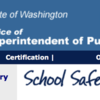 One of the hallmarks of a great 21st Century learning environment is that it is far more permeable in terms of two-way communication with parents, community members, and students than ever thought possible. This has also presented great challenges for education systems as the "millenials" look for learning conditions that are both supportive and safe.
One of the hallmarks of a great 21st Century learning environment is that it is far more permeable in terms of two-way communication with parents, community members, and students than ever thought possible. This has also presented great challenges for education systems as the "millenials" look for learning conditions that are both supportive and safe.
Protection of children accessing the Internet is not optional - it has been mandated. There is, however, great variability between districts in how students are kept safe while accessing the Internet. This is an area of ongoing learning for students, families, communities, educators and administrators.
In Washington State, this has been a focus for a number of years. You might consider sharing the link below with others who are looking for resources or strategies to promote 21st Century learning conditions and Internet safety. You might want to check out the resources available to educators in Washington State and compare them with those available in your state or the area where you know children attend school.
Cyberbullying & Digital/Internet Safety
The Internet offers a wealth of resources and material for education. Accessed through a variety of electronic devices, it also allows for rich and diverse opportunities for 21st Century communications. These devices are becoming ever more diverse and ubiquitous. They raise issues of digital / Internet safety and digital citizenship. Along with ensuring that our young people have the technological skills to effectively use digital devices, platforms, and resources for educational purposes, we also have the responsibility to teach them how to be safe and productive digital citizens of the 21st Century. This responsibility has been mandated through the Protecting Children in the 21st Century Act.
Within this context, Washington's anti-bullying law includes the prohibition of cyberbullying. Cyberbullying is bullying using electronic devices to initiate repeated negative behavior toward a less-powerful person. Electronic name-calling, shunning and shaming are all forms of cyberbullying. So are spreading rumors, gossiping and making threats online. Schools are permitted to discipline students who engage in cyberbullying if it disrupts the orderly operation of school. Additional HIB training materials are available on the Safety Center web site.
To access many resources on school Internet safety, go to:
http://www.k12.wa.us/SafetyCen...tSafety/default.aspx



Comments (0)